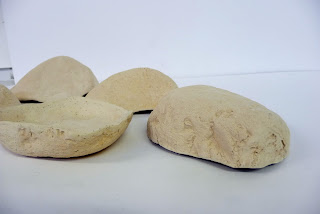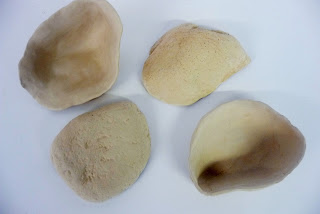As my project has developed, I have come away from making the small dishes and have began making rock inspired trinket boxes. Using a traditional Japanese method, I use wire tool to cut through the clay to create two halves and create a notch so the pieces can fit back together again. I then hollow out the insides of each halve using a clay tool, being careful not to alter the shape of the pieces as they still need to fit back together as neat and perfect as possible!
The hand built quality shows through as no piece is similar to the other, which portrays the fact that no rock or pebble is the same. By adding barnacle and limpet shapes it adds to the coastal feel of the pieces.
My pieces have decoration inside the boxes too, creating a surprise for the viewer as each one is different.
Charlotte Gaskin
Design Crafts student specialising in Ceramics
Monday, 8 April 2013
Wednesday, 20 March 2013
Ceramic pieces on Beer Beach
As my pieces are inspired by the sea and cliffs and have elements of coastal themes added to them, I decided to take them to Beer in Devon, where I was spending the weekend with the family. It seemed like an opportunity I couldn't miss, so I spent all of Monday glazing my pieces and hoping they would be out of the kiln in time for the weekend. After a bit of chasing up at Uni, I managed to get them just in time! I am very pleased with the glazes and how they compliment each other. These are just samples, not my final pieces but it gives a good idea of what glazes I will be using.
Thursday, 14 March 2013
Barnacles, limpets and shells ..
I felt my pieces were lacking in coastal inspiration, so to make them more natural and rock like, I used relief and sprig moulds to add texture that remind me of the coast. My pieces are reminiscent of rock pools embellished with shells, limpets and barnacles.
Glaze Tests
My glaze test pieces were intentionally pebble shaped to see how the glaze sits on different shapes and textures. By each pairing them up with different colours helps me see which colours work best as a contrast to one another. My favourite is the volcanic glaze that is a light green colour with specks of brown and a slight bubbling effect.
Rock Textured Forms
Here are the forms after their first firing. The texture is slight, but just enough to give the impression of rocks. By displaying them in different angles gives an idea of how they work best; as decorative ornamental pieces facing down or facing up as tea light holders or trinket bowls?
First Post!
As I am coming to the end of my time at De Montfort University I thought it was time to start a blog to show the development of my work. For my final major project I have focused on the coast and how the cliff edge meets the ocean. Ever since I was young, I went to the coast for holidays in Devon, sometimes spending the whole summer down there. Inspiration comes easily to me when focusing on something I enjoy looking at, so the coast and its natural forms felt like the best option.
Plaster Moulds..
By taking plaster moulds from rocks I was able to make clay forms by pressing into the moulds. They're bowl like and functional in shape, and would look great as a collection. I've added marks and indents to the insides of the forms to add texture. The outsides of the forms pick up the rock texture from the plaster, which has a softer and less noticeable effect to it.
Subscribe to:
Comments (Atom)

























